To build independent play habits through quiet time, choose calm, familiar spaces when your child is alert, and set clear, gentle boundaries. Offer age-appropriate, engaging activities that foster creativity and focus, like open-ended toys or simple puzzles. Keep routines flexible to match your child’s energy and interests, and monitor their engagement. By creating a nurturing environment and adjusting routines as needed, you support their confidence and independence—learn more about making quiet time effective for your child.
Key Takeaways
- Establish a consistent routine and dedicated space to help children associate quiet time with independent play.
- Provide age-appropriate, open-ended toys to encourage creativity and self-entertainment.
- Set clear, calm boundaries to foster self-control and confidence during quiet activities.
- Gradually increase quiet time duration based on child’s interest and engagement levels.
- Monitor progress and adjust routines to support development and prevent boredom or overstimulation.
Understanding the Benefits of Quiet Time for Children
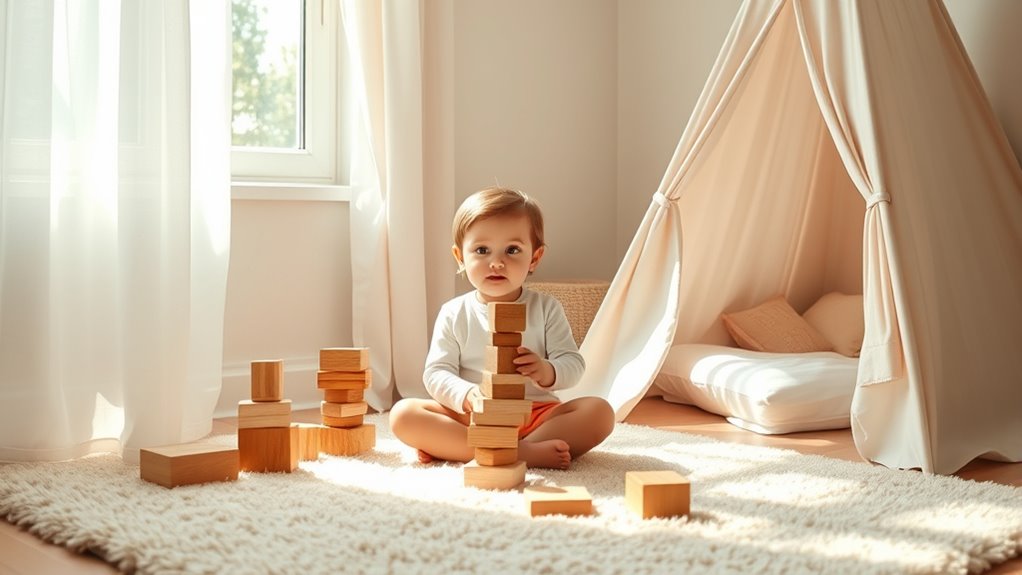
Quiet time offers children a valuable opportunity to recharge mentally and emotionally. During this period, kids can slow down and process their thoughts, feelings, and experiences. It helps improve their focus and emotional regulation, making it easier for them to handle daily challenges. Quiet time also encourages creativity, as children often engage in imaginative play or reflection without external distractions. Additionally, it fosters independence by allowing them to enjoy moments of solitude, building confidence in their ability to entertain themselves. Regular quiet time can reduce stress and anxiety, helping children feel more balanced and secure. Incorporating adjustable settings into quiet time routines, such as giving children control over their activities, can further enhance their sense of independence. Overall, implementing quiet time supports your child’s emotional well-being and development, laying a strong foundation for healthy habits and positive self-awareness.
Choosing the Right Time and Environment for Independent Play
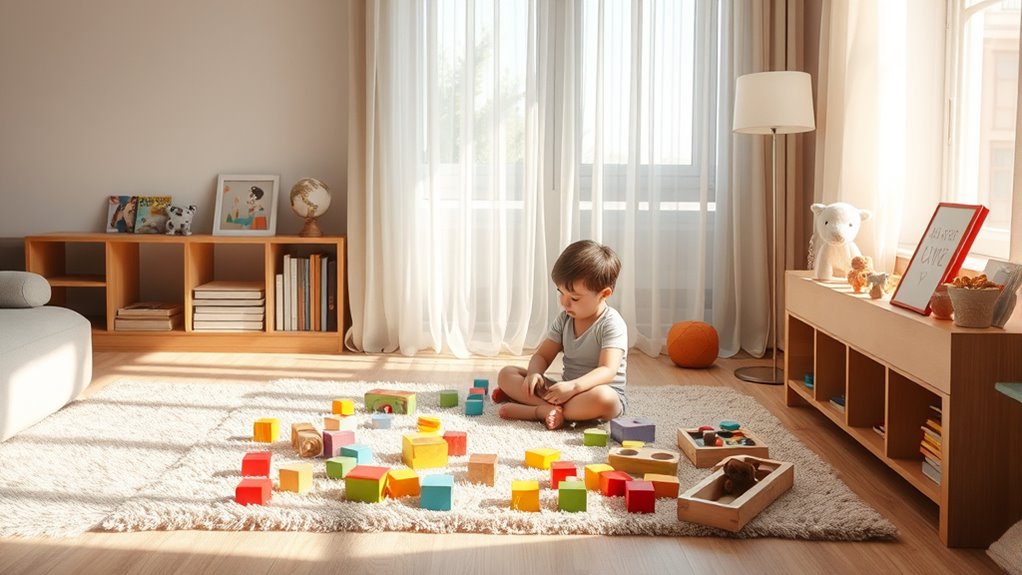
Choosing the right time and environment for independent play can make a significant difference in how your child benefits from quiet time. Pick moments when your child is naturally alert and not overly tired, like after a nap or a meal. Avoid busy or noisy settings that can distract or overstimulate them. Create a calm, inviting space with minimal clutter and familiar objects to foster comfort and curiosity. Guarantee the area is safe and easily accessible, so your child can freely explore without constant supervision. Consistency helps, so try to establish a regular routine and a dedicated spot for quiet time. When you choose the right time and environment, your child is more likely to embrace independent play and develop confidence in their ability to entertain themselves. Incorporating appropriate environmental factors can further enhance their focus and engagement during play.
Selecting Engaging and Developmentally Appropriate Activities
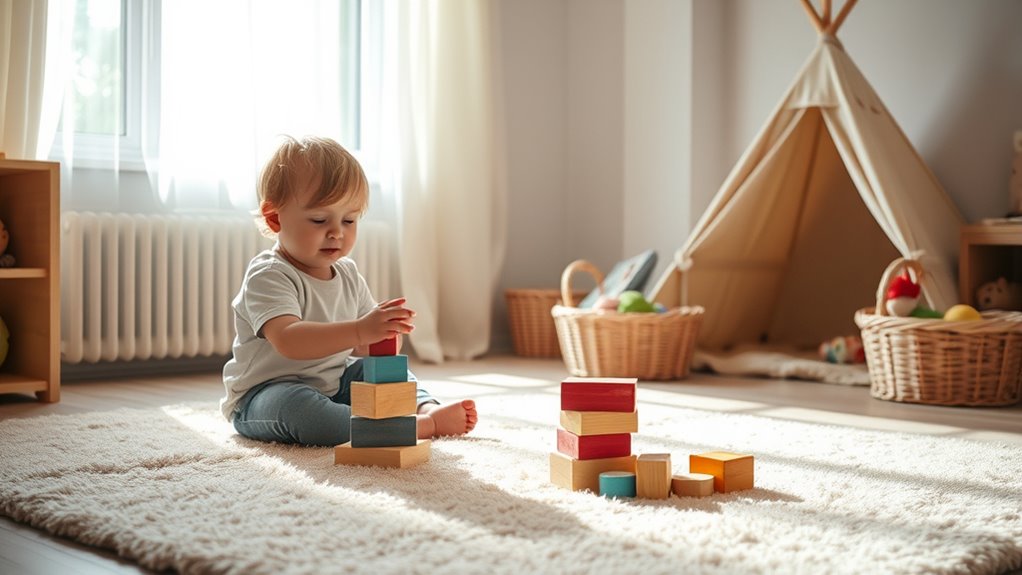
When choosing activities for quiet time, you want to pick options that match your child’s age and interests. Make sure the materials are stimulating but safe, encouraging exploration and learning. Aim for a good mix of active, quiet, and creative activities to keep your child engaged and support their development. Incorporating continuous learning into your child’s routine can foster a growth mindset and resilience from an early age.
Age-Appropriate Choices
Selecting activities that match a child’s age and developmental stage guarantees they stay engaged and benefit from their quiet time. When choosing options, consider their current skills and interests, ensuring tasks are neither too simple nor too challenging. For infants, soft books, simple puzzles, or textured toys work well, fostering sensory exploration. Toddlers benefit from stacking blocks, simple art supplies, or pretend play setups that encourage creativity and fine motor skills. Preschoolers thrive with activities like matching games, basic puzzles, or storytelling prompts that promote cognitive growth. By tailoring activities to their developmental level, you help build confidence and independence. Remember, age-appropriate choices keep children motivated and focused, making quiet time a valuable opportunity for growth and self-discovery.
Stimulating Materials Selection
To keep children engaged and promote development, it’s essential to select materials that are both stimulating and appropriate for their age. Look for items that challenge their current skills without causing frustration. For example, simple puzzles, textured fabrics, or basic building blocks encourage problem-solving and fine motor skills. Avoid overstimulating toys that may overwhelm or distract your child. Instead, choose open-ended materials that invite creativity and exploration, such as art supplies or natural objects like shells or leaves. Consider safety and durability, opting for non-toxic, sturdy options. Additionally, a high contrast ratio can enhance visual clarity and keep children focused on their activities. By thoughtfully selecting engaging, age-appropriate materials, you support independent play, foster curiosity, and help your child develop confidence in their abilities.
Balancing Activity Types
Choosing a variety of activity types helps children develop a well-rounded set of skills while keeping their interest alive. When selecting activities, aim for a balance between active, quiet, creative, and social play. This variety encourages physical development, cognitive growth, and emotional regulation. For example, include hands-on tasks like puzzles or building blocks, alongside calm activities such as reading or drawing. Incorporate opportunities for social interaction through cooperative play or group projects. Make sure each activity is developmentally appropriate, challenging but achievable. Rotating different types of activities prevents boredom and promotes skill diversity. Incorporating activities that promote mental well-being can enhance emotional resilience and reduce stress. By thoughtfully balancing activity types, you support your child’s independence, curiosity, and overall development, making quiet time productive and enjoyable for both of you.
Setting Clear Boundaries and Expectations
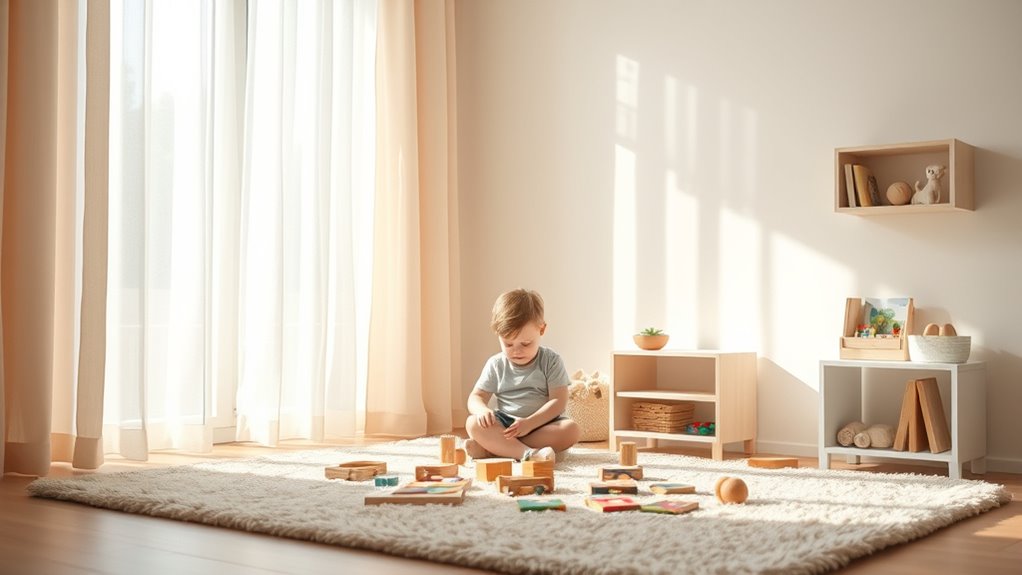
Establishing clear boundaries and expectations is essential for creating a peaceful and productive quiet time. You need to communicate your rules calmly and consistently, so your child knows what to expect. Set simple, specific guidelines, like staying seated, using quiet voices, or engaging with designated toys. Reinforce these rules each day, and follow through with gentle reminders or gentle consequences if boundaries are crossed. Consistency helps your child understand limits and feel secure. Avoid vague instructions; instead, be precise about what behaviors are acceptable. This clarity reduces confusion and helps your child develop self-control. When boundaries are clear, quiet time becomes a predictable routine, making it easier for your child to settle down independently and enjoy peaceful, focused play. Incorporating consistent routines can further enhance your child’s ability to adhere to boundaries and foster a sense of security during quiet time.
Encouraging Creativity and Imagination During Play

Once your child understands and follows quiet time boundaries, you can encourage their creativity and imagination during play. Provide open-ended toys like building blocks, costumes, or art supplies that invite exploration. Create a safe space where your child feels free to invent stories or scenarios without restrictions. Ask open-ended questions to stimulate their thinking, such as “What’s happening in your story?” or “Can you tell me more about your drawing?” Allow plenty of time for unstructured play, giving your child the freedom to lead. This nurtures their inventiveness and confidence. Incorporate educational toys that promote sensory development and problem-solving to further enrich their play experience. – Offer diverse, open-ended materials that inspire different kinds of play – Encourage storytelling and role-playing to spark imagination – Avoid directing play, instead letting your child explore independently
Monitoring Progress and Adjusting Routines as Needed
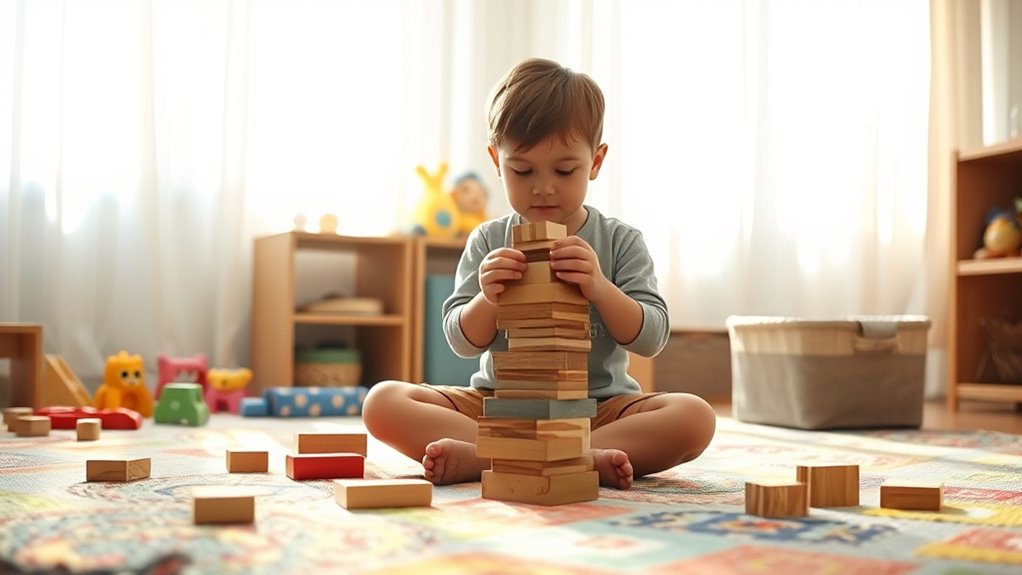
To make certain your routine stays effective, keep track of how long your child spends in quiet time activities. If you notice they’re losing interest or becoming restless, it’s helpful to adjust the schedule to better suit their needs. Staying flexible allows you to maintain a calm, engaging environment that supports their growth. Regularly monitoring your child’s engagement can also help identify productivity variances, enabling you to refine routines for optimal development.
Tracking Play Duration
Keeping track of how long your child spends during playtime helps you see their progress and identify patterns. When you monitor play duration, you can spot when they’re more engaged or becoming restless. This insight lets you adjust routines to maintain their interest and foster independence. Consider keeping a simple log or using a timer to measure play sessions consistently. This data helps you determine the right length for each activity and recognize when they’re ready for longer or shorter periods. Regularly assessing their engagement aligns with mindful decluttering strategies, ensuring that routines remain effective and supportive of their development.
Flexibility in Routine
Monitoring your child’s play duration provides valuable insights into their engagement and energy levels. As you observe, stay flexible and ready to adjust the routine based on their needs. If your child seems restless or loses interest quickly, consider shortening quiet time or changing activities to re-engage them. Conversely, if they’re comfortably engaged for longer periods, you might gradually extend quiet time to build independence. Remember, routines shouldn’t be rigid; they’re guides that support your child’s growth. Be attentive to cues, and don’t hesitate to modify the schedule to fit their developmental pace. Incorporating mindfulness practices can help both you and your child stay present and responsive during these routines. Flexibility helps prevent frustration and encourages a positive attitude toward quiet time, fostering a natural, enjoyable environment for independent play to flourish.
Frequently Asked Questions
How Long Should Each Quiet Time Session Last for Different Age Groups?
You’re wondering how long each quiet time session should last for different age groups. For infants, start with 10-15 minutes, gradually increasing as they grow. Toddlers can handle 20-30 minutes, while preschoolers and older children might enjoy 30-60 minutes. Keep sessions flexible and observe your child’s comfort level. Consistency helps develop independence, but always tailor the duration to their individual needs and attention span.
What Are Common Challenges Children Face When Developing Independent Play Habits?
When helping children develop independent play habits, you might notice they face challenges like difficulty focusing, needing constant reassurance, or feeling overwhelmed by new activities. You may also see resistance to playing alone or frustration if they don’t succeed right away. To overcome these, encourage small, manageable tasks, stay patient, and gradually increase playtime. Your support helps build their confidence and independence during play.
How Can Parents Handle Resistance or Tantrums During Quiet Time?
When your child resists or throws tantrums during quiet time, stay calm and consistent. Gently remind them of the routine and that quiet time is a special, safe space. Offer choices to give them a sense of control, like selecting a book or toy. Praise their efforts and be patient; over time, they’ll learn to enjoy independent play and feel secure during these moments.
Are There Specific Toys or Materials That Promote Better Independent Play?
Think of toys as keys that unseal your child’s creativity. You can promote better independent play by offering simple, open-ended toys like building blocks, art supplies, or pretend play sets. These materials act like blank canvases, inspiring your child to imagine and explore on their own. Keep a variety of these toys accessible, and you’ll encourage their confidence and independence during quiet time.
How Can Caregivers Gradually Increase a Child’s Independent Play Duration?
You can gradually increase a child’s independent play duration by starting with short periods and slowly extending them. Encourage your child with praise and gentle support, making sure the environment is safe and engaging. Offer interesting toys and activities that match their interests, and stay nearby initially to provide reassurance. Over time, as they become more comfortable, you’ll notice they can play independently for longer stretches.
Conclusion
Incorporating quiet time into your child’s routine boosts their independence and creativity. Studies show that children who engage in regular independent play develop better problem-solving skills and emotional resilience. By setting clear boundaries and choosing engaging activities, you help your child build confidence and imagination. Remember, consistency is key—over time, you’ll notice your child’s ability to play independently grow stronger, giving them valuable skills for life.









